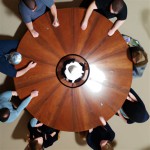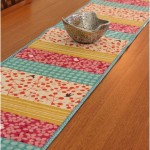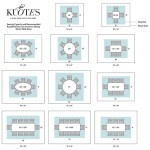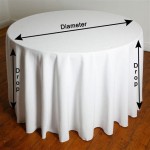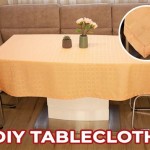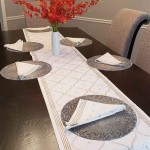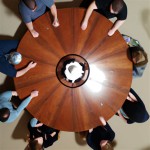How to Make Table Runners: A Step-by-Step Guide
Table runners are a versatile and stylish way to enhance the aesthetics of your dining table, adding a touch of elegance and personality to any occasion. Whether you're hosting a formal dinner party or a casual gathering, a well-chosen table runner can instantly elevate the ambiance. While you can purchase ready-made runners, crafting your own allows for greater customization and a unique, personal touch. This guide provides a comprehensive overview of how to make table runners, covering essential materials, techniques, and tips for achieving professional results.
Materials and Tools
Before embarking on your table runner creation, gather the necessary materials and tools to ensure a smooth and enjoyable crafting experience. The following list includes essential components:
- Fabric: Choose a fabric that complements your dining table and the overall theme of your décor. Cotton, linen, silk, and velvet are popular options, offering a range of textures and aesthetics.
- Scissors: Sharp fabric scissors are crucial for precise cutting. Avoid using regular scissors as they can fray the fabric.
- Sewing machine: While a sewing machine isn't strictly necessary, it's highly recommended for a professional finish. Alternatively, you can use a needle and thread.
- Fabric glue: Fabric glue can be helpful for adhering seams and preventing fraying.
- Measuring tape: Accurately measure your table to determine the optimal length and width of your table runner.
- Iron: An iron is essential for pressing seams and creating a crisp finish.
- Pins: Pins help secure fabric during cutting and sewing, preventing shifting and ensuring precise alignment.
- Thread: Choose thread that matches the color of your fabric or complements it.
- Optional embellishments: Consider adding embellishments such as lace, buttons, or embroidery to personalize your table runner and enhance its design.
Design and Cutting
Once you have gathered your materials, the next step is to design your table runner. This involves determining the desired dimensions and considering any embellishments or special features you wish to incorporate. Here's a step-by-step process for designing and cutting:
- Measure your table: Use a measuring tape to determine the desired length and width of your table runner. The length should typically extend beyond the edges of the table, while the width can vary depending on your preference.
- Sketch your design: Sketch a rough outline of your table runner on paper, including any embellishments or special features. This helps you visualize the final result and ensure accuracy.
- Transfer your design to the fabric: Using a pencil or fabric marker, carefully transfer your design onto the fabric. Ensure the fabric is flat and smooth to prevent distortion.
- Cut the fabric: Using sharp scissors, cut out your table runner according to your design. Leave a small seam allowance around the edges to accommodate hemming.
- Press the seams: Once cut, press the seams of your table runner using an iron. This helps create a crisp and professional finish.
Sewing and Finishing
Sewing your table runner involves securing the edges and creating a polished finish. The following steps guide you through the sewing process:
- Hem the edges: Fold the edges of your table runner inward by 1/4 inch and press with an iron. Repeat for all edges. Then, fold the edges inward again by 1/4 inch and press.
- Sew the hems: Using a sewing machine or needle and thread, sew along the folded edge of each hem to secure it. Alternatively, you can use fabric glue to adhere the hems.
- Add embellishments (optional): If you've chosen to incorporate embellishments, such as lace or buttons, attach them to your table runner at this stage. You can sew, glue, or use other techniques depending on the embellishment and your preference.
- Iron the final product: Once sewn, iron your table runner to remove any wrinkles or creases. This step ensures a crisp and professional finish.
Tips for Professional Results
Achieving a professional finish for your handmade table runner requires attention to detail and some strategic techniques. The following tips help enhance the quality and appearance of your creation:
- Use high-quality fabric: Investing in high-quality fabric ensures durability, a luxurious feel, and a professional look.
- Choose a contrasting thread: If you're using a sewing machine, choose a thread color that contrasts slightly with your fabric, adding visual interest and enhancing the seam's visibility.
- Use a walking foot (optional): A walking foot attachment for your sewing machine can be particularly helpful for sewing thick fabrics, ensuring even feeding and preventing puckering.
- Trim your seams: After sewing, trim the raw edges of your seams closely to reduce bulk and create a cleaner finish.
- Press your seams regularly: Pressing seams after each step helps maintain a smooth and uniform finish.
- Experiment with different fabrics and designs: Don't be afraid to experiment with various fabrics, patterns, and embellishments to create unique and personalized table runners.

How To Make A Reversible Table Runner For Beginners

How To Make A Table Runner 3 Easy Diy Runners Treasurie

Beginners Table Runner Very Detailed Instructions

Diy No Sew Table Runner Homey Oh My

How To Make A Reversible Table Runner For Beginners

How To Sew A Table Runner 14 Steps With Pictures Wikihow

One Hour Version Of The 10 Minute Table Runner Super Mom No Cape

How To Make A Table Runner An Easy Step By Guide Quilting Life

How To Make A Table Runner The Easy Way Semigloss Design

Tutorial How To Make A Simple Table Runner Sew My Place
Related Posts

